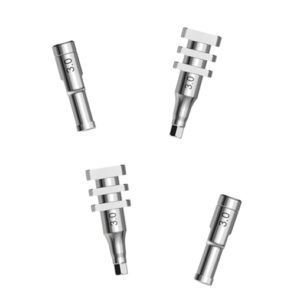
Titanium implant abutment In-Kone®internalangledscrew
Add to favorites
Compare this product
Characteristics
- Material
- titanium
- Connection
- internal
- Configuration
- screw, angled
- Positioning
- transgingival
Description
The In-Kone® prosthesis range offers a large selection of abutments to meet a wide range of clinical situations. The purpose of the components’ transgingival neck silhouette is to enable development of a maximally extensive and stable mucosal seal.
STANDARD ABUTMENTS
Standard abutments present a symmetrical shoulder that can be partially adjusted to integrate harmoniously with gingival contour irregularities. A colour code indicating periodontal height associates the abutments with different healing screw references to adopt a tension-free emergence profile. They are indicated as a matter of priority for the manufacture of single and multiple cement-retained prostheses. They can also be used in the construction of single screw-retained prostheses.
PROFILED ABUTMENTS
Profiled abutments have an ‘anatomical’ shoulder designed to adapt to periodontal profiles that display asymmetrical thicknesses of the palatine and vestibular mucosae and which are generally encountered in the anterior sector of the maxilla. These abutments are indicated as a matter of priority for the construction of cement-retained prostheses with aesthetic aims.
Catalogs
Related Searches
- Implant abutment
- Titanium implant abutment
- Straight implant abutment
- Internal implant abutment
- Radiology software
- Viewer software
- Dental implant
- Titanium dental implant
- Screw implant abutment
- Angulated implant abutment
- Scheduling software
- Dental software
- Bone substitute
- Tapered dental implant
- Scan software
- Treatment software
- External implant abutment
- Cylindrical dental implant
- Hexagonal dental implant
- Impression cap
*Prices are pre-tax. They exclude delivery charges and customs duties and do not include additional charges for installation or activation options. Prices are indicative only and may vary by country, with changes to the cost of raw materials and exchange rates.

























